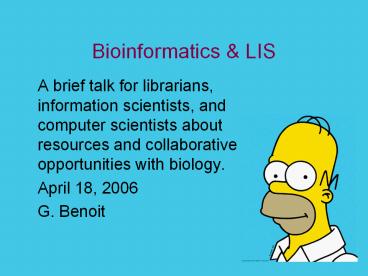Bioinformatics - PowerPoint PPT Presentation
1 / 23
Title:
Bioinformatics
Description:
Bioinformatics & LIS A brief talk for librarians, information scientists, and computer scientists about resources and collaborative opportunities with biology. – PowerPoint PPT presentation
Number of Views:127
Avg rating:3.0/5.0
Title: Bioinformatics
1
Bioinformatics LIS
- A brief talk for librarians, information
scientists, and computer scientists about
resources and collaborative opportunities with
biology. - April 18, 2006
- G. Benoit
2
Outline of the talk
- Bioinformatics defined
- Generation of data
- Tools and databases
- Activities for Librarianship,
- Computer and
- Information Science
- Examples
- Entrez, NCBI, Visualization
- Collaborations
3
Bioinformatics defined
- Over 70 defintions
- Differences arise from the work
- Natl Center for Biotechnical Information (NCBI)
- The development of new algorithms and statistics
with which to assess relationships among members
of large data sets - The analysis and interpretation of various types
of data including nucleotide and amino acid
sequences, protein domains, and protein
structures and - The development and implementation of tools that
enable efficient access and management of
different types of information.
4
Without getting into the science
- How the data started
- Four chemical bases (purines adenine (A), guanin
(G) and pyrimidines cytosine (C) and thymine
(T) ) - Their precise order and linking (attached to a
sugar molecule and to a phosphate molecule to
create a nucleotide)
5
DNA
6
- A pairs with T G with C to make unique and very
long strings, called sequences - E.g., AATGACCAT codes for a different gene than
GGGCCATAG would - Replication RNA consists of A, G, C, and Uracil
and has ribose instead of deoxyribose - Point is one can predict missing data, sometimes
7
In short
the nucleotides are linked in a certain order or
sequence through the phosphate group their
precise order and linking within the DNA
determines what proteins the gene produces and
the phenotype of the organism
8
Generation of Data
- Raw data from sequencing
- Expression data
- Data generated by linking other raw data in very
large, multidimensional databases (e.g., OMIM) - Research literature (full-text journals)
- Data models to describe the literature for
retrieval, linking to other data, and linking to
the raw data - New data models to support greater
- flexibility in describing manipulating
- data
9
Generation of Data
- To support integrated search and retrieval
- To focus on single organisms or find similarities
across them - Feed other technology
- Visualization of natural phenomena and of
abstract phenomena
10
Tools Databases
- A host of tools for database searching
- BLAST (basic local alignment search tool)
- FASTA (sequence strings)
- ChopUp (protein analysis)
- Integrated packages (Lasergene Sequence Analysis
Software) - The many services offered through
- NCBI and NLM
11
- Take a look at handout, Table 1, publically
accessible databases
12
Data Categories
- Monographs, Journals, Announcements (text)
- Datasets
- Bibliographic (http//www.expasy.org/links.html)
- Taxonomic
- Nucleic acid
- Genomic (e.g., GDB, OMIM)
- Protein DB (SwissProt, TrEMBL)
- Protein families, domains, and functional sites
- Proteomics initiative
- Enzyme/metabolic pathways
- Sequence Retrieval System (SRS) and NCBI Data
Model
13
- Take a look at handout, Table 2,
publically-accessible databases defined and then - Entrez sample, Table 3
14
Entrez example
- Notice the familiar access points (author,
journal, title) as well as domain-specific ones
(exon, gene, organism) - Notice, too, the DNA
15
NCBI Homepage
- http//www.ncbi.nih.gov/
- Notice the variety of tools (left menu)
- Site map http//www.ncbi.nih.gov/Sitemap/index.ht
ml - Alpha list http//www.ncbi.nih.gov/Sitemap/AlphaLi
st.html
16
Linking across resources
- http//www.ncbi.nlm.nih.gov/entrez/query/static/li
nking.html - NCBIs structure database is called Molecular
Modeling Database (MMDB), and is a subset of
non-theoretical models 3D structures obtained
from the Protein Data Bank (PDB). Data are
obtained from X-ray crystallography and
NMR-spectroscopy. Goal is to make it easier to
compare structures. - Searching variety of access points author,
title, text terms, or a PDB 4-character code or a
numerical MMDB-id - MMDB Data PDB records are parsed (to extract
sequences and citations from PDB records, and
structural info). Converted to ASN.1. - Taxonomy is used to help end users see term
relationships and databases, along with
literature references - Example http//www.ncbi.nlm.nih.gov/Taxonomy/ta
x.html/ - http//www.ncbi.nlm.nih.gov/Taxonomy/Browser/wwwta
x.cgi?modeUndefnameEscherichiacolilvl0srchm
ode1
17
Linking across resources
- XML - there are hundreds of XML schema used in
biology - Calls for mapping to ASN1 records see NCBI
example - Calls for mapping across schema
- Calls for exporting data for different devices
18
Visualization
- Cn3D - uses MMDB-Entrezs structure database
- http//www.ncbi.nlm.nih.gov/Structure/CN3D/cn3d.sh
tml - RasMol http//www.umass.edu/microbio/rasmol/
- Protein Explorer http//www.umass.edu/microbio/ras
mol/rotating.htm - OpenRasMol http//www.openrasmol.org/
- MolviZ.org http//www.umass.edu/microbio/chime
- World Index of Molecular Visualization
http//molvis.sdsc.edu/visres/index.html
19
Recap main points
- Very large data sets - homogenized thru ASN.1
- Goal to integrate (text-text, visualization-text,
text-vis) - Raw data research literature visualization
- Biologists provide domain knowledge
- XML is a big player
- CS and IS provide technology
- Librarians provide maintenance and access to
resources
20
Collaborative Opportunities
- For LIS and CS
- Domain analysis
- information use, communication, theories of
information - systems analysis and design,
- data modeling,
- classification,
- storage and retrieval,
- HCI mapped onto a generalized model of a
molecular biology experimental cycle - Denn MacMullen, 2002, p. 556
21
Collaborative Opportunities
- Insertion Points - development of new tools and
methods for managing, integrating visualization - For local use download selected
- data sets for local needs
- (Stapley Benoit, 2000)
- XML Transformations
- XML - SVG - X3D
- Automated retrieval
- Clustering (data- and text-mining)
22
Collaborative Opportunities
- Biologists needs
- To go beyond mining of genomic data to
investigate causal entailments in intra- and
intracellular dynamics - LISs response
- To aid understanding of the scientific processes
thru visualization of literature, metadata and
graphic representations in general and for
disease-specific analysis
23
Back to you
- Thanks
woo-hoo!

